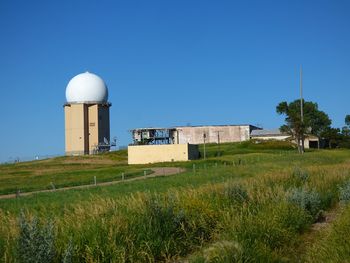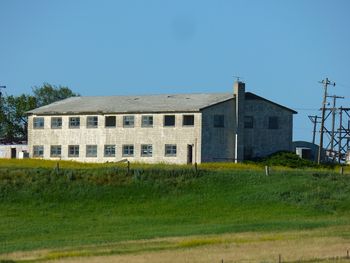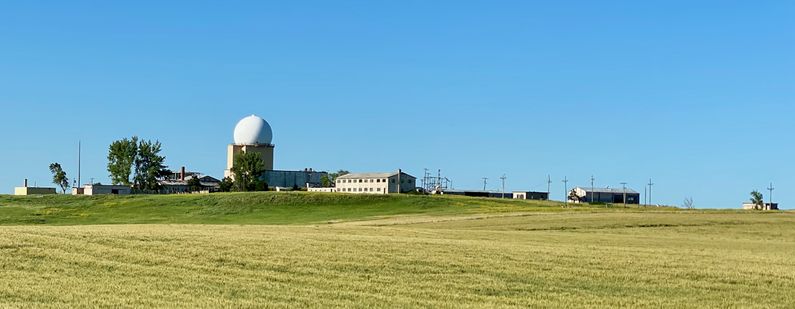Gettysburg Air Force Station
|
Gettysburg Air Force Station (1956-1968) - A Cold War Air Force Radar Station first established in 1956 near Gettysburg, Potter County, South Dakota. Named Gettysburg Air Force Station after the location. Initially assigned a Permanent ID of M-99, a Sage ID of Z-99 and later an FAA ID of ZQJB. Abandoned by the Air Force in 1968. The FAA activated the Gettysburg FAA Radar Site in 1971 on a small site surrounding the old Air Force FPS-27 radar tower. HistoryConstructed in 1955 by the contractor Lippert Brothers of Boone, Iowa, and accepted by the Air Force in January 1956. The initial cadre was 25 airmen, 3 officers and 3 civilians under the command of Captain A. M. Hedvall. The first meal was served in the newly constructed mess hall on 21 Feb 1956. The site became operational on 5 Jul 1956 as Gettysburg Air Force Station manned by the 903rd AC&W Squadron. The station initially had both a Ground-Control Intercept (GCI) and early warning missions. The early warning mission involved tracking and identifying all aircraft entering their airspace while the GCI mission involved guiding Air Force interceptors to any identified enemy aircraft. Controllers at the station vectored fighter aircraft at the correct course and speed to intercept enemy aircraft using voice commands via ground-to-air radio. Initial equipment included the MPS-7 search radar and one MPS-14 height-finder radar. The radars were upgraded to one FPS-20A and one FPS-6A height-finder radar. This configuration established the minimum requirements for transition to the SAGE System operation. 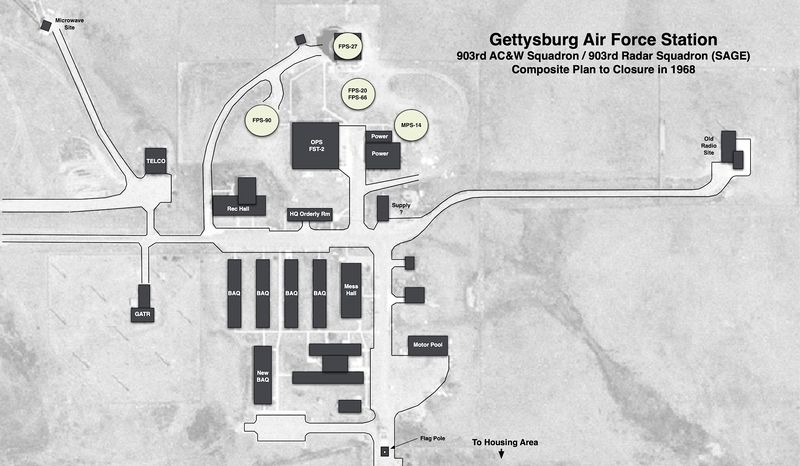 SAGE System Transition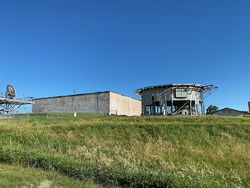 The transition of the manual GCI system to the automated SAGE system began with the installation of the FST-2 coordinate data transmitter and search radar upgrades. The FST-2 equipment digitized the radar returns and transmitted the digital returns to the SAGE direction center. Under the SAGE System, interceptor aircraft were directed to their targets by the direction center computers and controllers, greatly reducing the need for local controllers and equipment at every radar station. The FST-2 was a very large digital system using vacuum tube technology. Over 6900 vacuum tubes were used in each FST-2 requiring 21 air-conditioned cabinets, 40 tons of air conditioning, 43.5 kva of prime power, and usually a large new addition to the operations building. The FST-2B modification added two more cabinets but with newer solid-state (transistor) technology to process coded responses from aircraft transponders.
SAGE System Operation
The site began operation as a SAGE site in 1959 initially feeding the Grand Forks SAGE Direction Center DC-11. The search radar was upgraded to a FPS-66 and then replaced by a FPS-27 search radar circa 1962. In 1963 the Grand Forks SAGE Direction Center DC-11 closed and control shifted to the Sioux City SAGE Direction Center DC-22. The Sioux City SAGE Direction Center DC-22 was then selected to close on 18 Sep 1968 and Gettysburg Air Force Station was closed just three months before that. ClosureGettysburg Air Force Station and the 903rd Radar Squadron (SAGE) were deactivated on 18 Jun 1968. Approximately one acre of land surrounding the vacant FPS-27 tower was set aside for FAA use and the remainder of the land was disposed of by the government. Gettysburg FAA Radar Site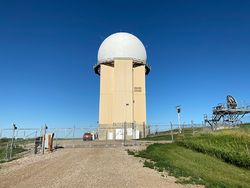 The Gettysburg FAA Radar Site opened in January 1971 on a one-acre portion of the former Gettysburg Air Force Station. The FPS-27 had been removed from the tower and the FAA emplaced a FPS-67B search radar and radome on the FPS-27 tower. A FYQ-47 Common Digitizer was added to transmit the radar data to Minneapolis ARTCC and Denver ARTCC. A FYQ-47 Common Digitizer was probably placed in service by February 1973 when the USAF/FAA FST-2 to FYQ-47 replacement program was completed. By 1990 the site was equipped with an FPS-67B search radar and a CD-2A Common Digitizer. The Gettysburg CD-2A was scheduled to receive an upgrade kit to implement three level weather data processing in March 1992.
Mode S Beacon System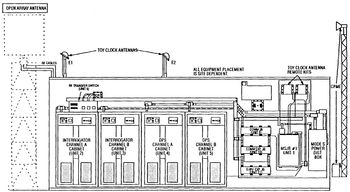 The Gettysburg FAA Radar Site was selected in the 1990s to become one of 21 long-range radar sites to have a Mode S radar beacon system installed. The Mode S system allowed operation in the existing beacon modes but added features to improve beacon operation by allowing aircraft identification with a single interrogation and two-way digital communication between controllers and pilots. Besides the 21 long-range sites, there were other short-range radars to be upgraded for a total of 137 sites on the implementation list. Gettysburg was #132 on the list, scheduled to receive the Mode S equipment on 30 Jul 1995. Installation required interfacing with the radar system, addition of a beacon antenna on top of the search radar antenna, a new larger radome, interfacing with the Common Digitizer (CD-2) if installed, additional communication lines and equipment. CARSR RadarThe nationwide replacement program converting FAA legacy radar systems to the CARSR radar configuration was completed by 17 Aug 2015 and Gettysburg FAA Radar Site was a part of that program. Legacy FAA radars underwent a Service Life Extension Program (SLEP) that replaced key components in the vintage ARSR-1, ARSR-2, FPS-20, FPS-66 and FPS-67 radars. The CARSR program replaced legacy klystron radar transmitters with a solid-state transmitter as well as renovating the radar receiver and signal processor. The CARSR modification also included common digitizer functionality making a separate common digitizer unnecessary. The Gettysburg FAA Radar Site is now operating with the CARSR radar. The secondary radar at this site is a Mode S Beacon set. The radar site data is now available to the USAF/NORAD Battle Control System-Fixed (BCS-F) operations centers (EADS & WADS) as well as the FAA Minneapolis ARTCC (ZMP) and adjacent ARTCCs. Other federal agencies have access to the data under the Homeland Security umbrella. Physical Plant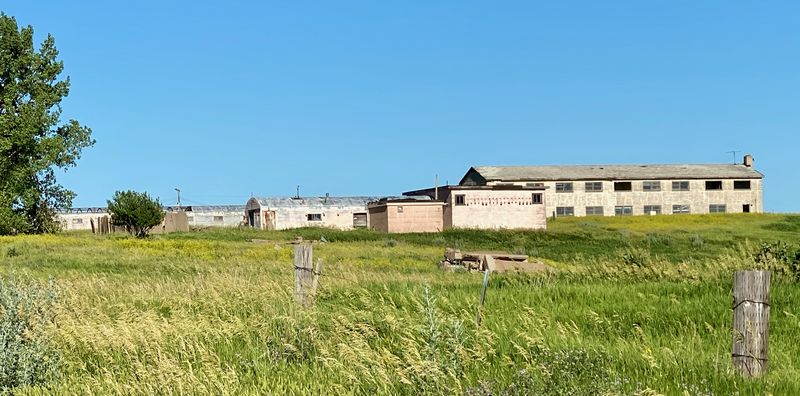 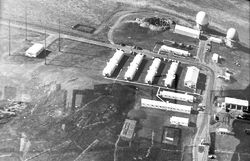 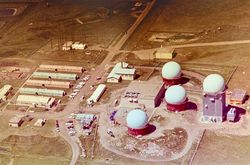 The physical plant of the Air Force Station was divided into the main site, a cantonment area, a separate housing area, and two radio sites. The main site housed the operations buildings, the radar towers, and the backup generators. The cantonment area housed the enlisted barracks, the bachelor officer's quarters, the orderly room, the dining hall, the motor pool, and other support buildings. Apart from the main site was a small 27 unit housing area for married personnel located just south of the cantonment area. Because this site was initially considered a mobile radar site very few of the buildings were permanent construction and most were considered relocatable. This included the 27 unit family housing area which was relocated after the radar site closed. All of the cantonment area and the main site area buildings were left in place when the site closed and they were sold with the property. A separate radio site housed the radio equipment for directing aircraft intercepts. Like most early radar stations, Gettysburg originally had a radio transmitter site and a separate radio receiver site used by local controllers for voice direction of fighter interceptors to their targets. With the SAGE System, the SAGE Direction centers had the primary task of directing intercepts and the local radio sites were reconfigured, usually into a single site that was known as the Ground to Air Transmitter Receiver (GATR) site. The GATR site communicated with the interceptors from either the local site or the SAGE direction center via voice commands and/or a digital data link.
Current StatusAbandoned by the Air Force to private interests except for about one acre used by the Gettysburg FAA Radar Site.
See Also:
Sources:
Links: Visited: 1 Jul 2020 |
